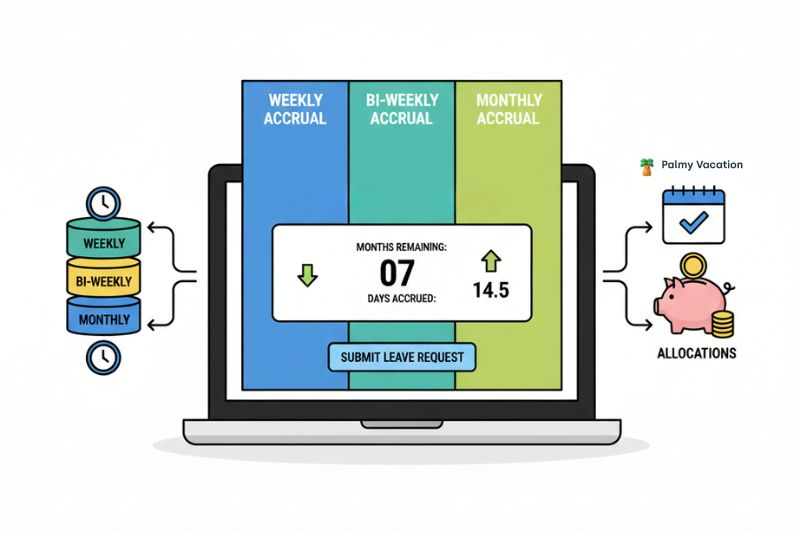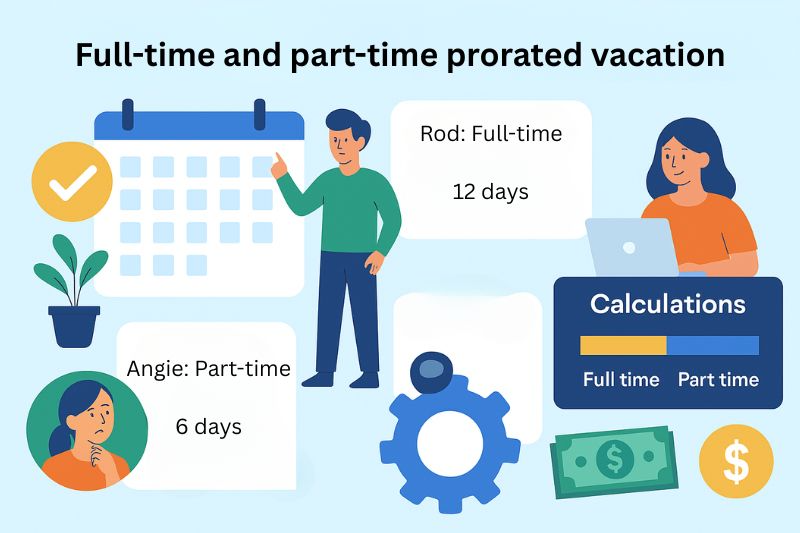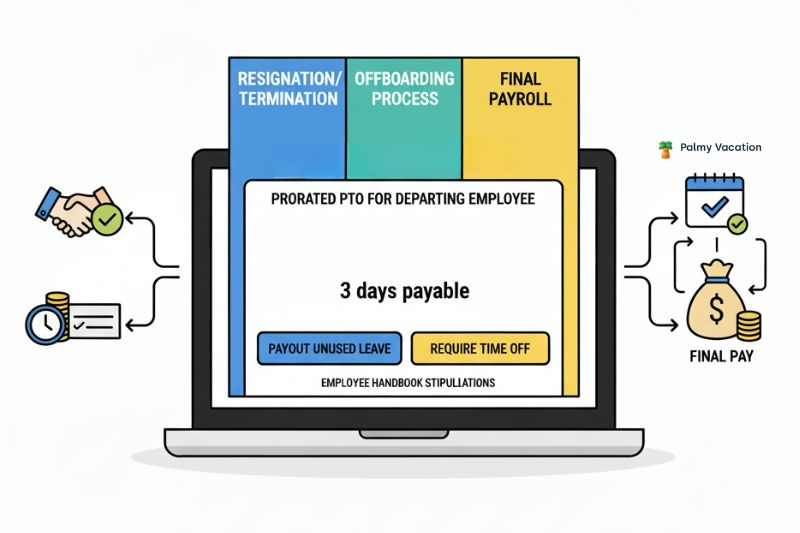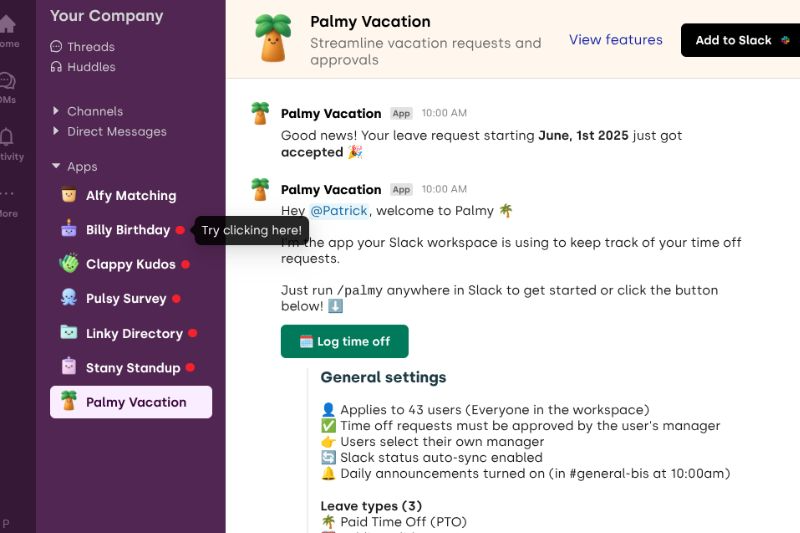Prorated PTO Meaning: The Ultimate Guide for Managers
Learn what prorated PTO means, how to calculate it for full-time and part-time employees, and how to handle prorated vacation for resignations with ease as a manager.

As a manager, you will often field questions from new hires, resignations, and part-time employees about their leave allocation. They wonder why their vacation time looks different to full-time employees, and it falls on your shoulders to explain clearly why it looks the way it does.
Understanding how it works helps you stay compliant with labor laws and company policies, and ensures that leave is allocated fairly and equitably across the board. This ultimate guide breaks down what prorated PTO means, how it shows up in pay, and what you need to know to answer questions with clarity.
Quick Overview
Prorated paid time off (PTO) is an amount of paid time off that has been adjusted to reflect the amount of time an employee has worked. It is a proportionate distribution of a standard PTO allocation which ensures fairness for all employees - especially those who have not worked a full calendar year. Prorated vacation days typically apply to part-time employees, new hires, and employees who experience mid-year terminations.
Table of Contents
- How is prorated PTO calculated?
- Calculate prorated vacation days for full-time employees
- Prorated PTO calculations for part-time employees
- Dealing with prorated PTO for resignations
- Conclusion
- Frequently Asked Questions

How is prorated PTO calculated?

Calculations for PTO are based on company policies and legal requirements, but commonly it is apportioned on an accrual basis, or as a lump sum at the start of the year (also called Flexible Time Off).
Accrual prorated vacation days
Prorated vacation time that is apportioned on an accrual basis can be given on a weekly, bi-weekly, or monthly basis. It is based on the time period an employee has worked for the company. To calculate prorated PTO, use the following calculation:
(Total annual PTO days ÷ Total workdays per year) × Days worked
For example, if employees receive 20 PTO days per year and work 5 days per week (260 workdays per year):
- Weekly accrual: 20 ÷ 52 = 0.38 days per week
- Biweekly accrual: 20 ÷ 26 = 0.77 days per paycheck
- Monthly accrual: 20 ÷ 12 = 1.67 days per month
Once you’ve established what the employee is entitled to, you can use that amount and multiply it by the time worked. Using monthly accrual and assuming an employee worked for six months:
- 1.67 x 6 = 10.2 prorated vacation time granted (usually rounded up to the whole numbers)
Flexible time prorated vacation days
In the case of flexible time off, the situation would be similar. The employee would receive ten days' leave at the start of employment, to be used for the remaining six months of the year. If the employee leaves before the six months are up, and has used all their leave, employers commonly claw back the number of vacation days.
If your team is working in Slack, there’s an easier way to manage vacation leave balances and leave requests. With Palmy Vacation, you can calculate vacation days, view employees' leave balances, approve leave requests with a single click, and identify who has unused vacation days. Connect Palmy Vacation to Slack, and automate your leave process within minutes.
📚 Further insight into PTO: Understanding PTO Rollover: Key Insights for Employers

Calculate prorated vacation days for full-time employees
For employees on a full-time schedule who start or leave mid-year, prorating vacation days ensures that their entitlement matches the portion of the year they have worked. The calculation is straightforward:
- (Annual vacation days ÷ 12 months) × months worked
Example:
- Company A grants a vacation entitlement of 24 days per annum.
- An employee’s start date is July 1 (six months remaining in the year).
- Calculation: 24 ÷ 12 × 6 = 12 prorated vacation days
This method is used to maintain fairness, giving the employee the vacation time they deserve for the amount of time they have worked. Employers can choose to round up to the nearest whole day or to round down to the nearest half day; these stipulations should be clearly explained in vacation policies.
Further reading: The state of paid time off in the US

Prorated PTO calculations for part-time employees
For part-time employees, calculations are based on the number of hours or days they have worked. The formula looks like this:
(Annual PTO entitlement for full-time × part-time number of hours worked) ÷ full-time hours
Example:
- Full-time employees receive 20 PTO days per year.
- Full-time hours are 40 hours per week.
- Average hours of a part-time employee = 20 hours per week (50% of full-time).
- Calculation: 20 × (20 ÷ 40) = 10 prorated PTO days per year
Example for a mid-year start:
- A part-time employee works 20 hours per week (50% of full-time).
- Full-time entitlement is 24 days.
- Start date: July 1 (six months).
- Step 1: 24 × (20 ÷ 40) = 12 days per year.
- Step 2: 12 ÷ 12 × 6 = 6 prorated vacation days.
📚 Further insight into PTO: How to calculate PTO: Part-time employees
Dealing with prorated PTO for resignations

Prorated PTO doesn’t just apply to new hires and part-time employees - it is equally important when an employee resigns (or is terminated). As a manager, you’ll need to know how much leave an employee has accrued by their final day of work. This is essential for both final payroll and a successful offboarding process.
It is common for employers to require employees to use or forfeit unused vacation time before they depart, or for it to be paid out as part of their final paycheck. These stipulations are outlined in the employee handbook and must be adhered to by all employees leaving the company to maintain fairness and consistency. The calculation is as follows:
(Annual PTO entitlement ÷ 12 months) × months worked in the year – PTO already taken
Example:
- Employee entitlement: 24 days annually
- Resignation date: End of April (4 months worked)
- Accrued PTO: 24 ÷ 12 × 4 = 8 days
- PTO already used: 5 days
- Balance payable: 3 days
The reverse can also happen if the employee has taken more leave than they’ve accrued by a certain time period. Employers may request that these days be repaid, and will usually deduct the amount from the final paycheck.
To avoid conflict and unpleasant interactions at the time of employment termination, rules governing accrued vacation should always be clearly communicated.
Tools that make prorating easier

Manually calculating prorated vacation time can be time-consuming and prone to error. This is especially true when you’re juggling employees with different start dates, work schedules, and vacation policies. This is where a vacation tracker, like Palmy Vacation, makes life a whole lot easier. Integrated directly into Slack, Palmy automates leave calculations, tracks balances in real-time, and ensures that prorated days are applied correctly.
Instead of crunching numbers, you get clear, automated reporting that keeps everyone on the same page — and compliant with company policy.
👋 Don’t waste time looking for a better solution - start using Palmy Vacation in Slack now.
Conclusion
Prorated PTO can be a challenge for managers who need to handle new hires, resignations, and part-time employees who require a PTO calculation based on the time they have worked. Errors and misunderstandings can easily creep in and affect the relationship you have with your employees. Empower yourself to answer prorated PTO questions easily and clearly with this guide from BuddiesHR. If you need a quick way to calculate vacation days, use our PTO accrual calculator.
📚 Further insight into PTO: Guide to PTO Accruals: Everything you need to know
Average PTO for small business: Are you competitive?

Frequently Asked Questions
1. What does it mean when your leave is prorated?
Prorated vacation refers to the amount of leave you are entitled to, which has been adjusted to accurately reflect the number of days you have worked. This can be either a portion of a year or an employment period. For example, if you’re entitled to 20 days leave per year, but only joined a company with six months of the year left, you are only entitled to 10 days leave.
2. What does prorated mean on a payslip?
If an amount is prorated on your payslip, it means you have only received a portion of the benefits or pay because you didn’t work the full period. This often happens when you leave or start a job during the year, or work part-time.
3. How does your PTO work?
Paid time off (PTO) represents an allocation of vacation, sick, personal, and other paid time off that is granted to you as a benefit. It can accrue over time or be given to you at the start of the year. Some employers allow you to carry over unused vacation days into the next year, and others have a ‘use-it, or lose-it’ policy.
4. What does it mean when benefits are prorated?
When benefits are prorated, it means you only receive a portion of what you would be entitled to in a full year or pay period. For instance, if bonuses, increases, or leave are allocated based on working a full year, you may only receive a percentage of the benefit based on the time you’ve worked.




